A Full Exhaustive Guide for Castling in Chess w/pictures
Castling is the only move in chess where a player is allowed to move two pieces at the same time. This speeds up the process and gets the game going much quicker than moving the king and rook one by one for example.
It is an essential part of being a chess player, so I’ve decided to make a guide that would make it easier to introduce this concept, What is castling, how is it performed, and why is it performed?
Castling is performed by switching the king two tiles towards the direction of the rook while there are no pieces in between, where the rook gets swapped accordingly.
It cannot be fully executed when one of the two pieces involved has already moved initially.
I’m going to provide my explanation of everything so hang tight while a go about it one by one.
What is castling in chess?
Castling is a special move in chess involving the king and any of the two rooks at the side. It is called special in the sense that it is not a recurring theme for all the other pieces. This is the only time when two pieces can move in only one turn.
It gives the player a lot of flexibility to work on by keeping the King safe.
It has become such an essential component of every chess game that it warrants its own strategies. Castling or not castling at all can tremendously dictate how the rest of the game will be played.
This is why it is so important for a beginning player to understand the basics in order to make good castling decisions.
Most likely than not, the side who castled will likely win the game than the one who doesn’t. But before we get into all of that it’s time to learn what is castling exactly?
Why is it so special? And just the general background of how you do the thing. There are actually two types of castling that we need to learn.
Short Castle
As expressed by the name, this kind of castle is performed with the rook nearest to the king. It is short in terms of distance that only requires getting a few pieces out of the way.
Look at the diagram below:
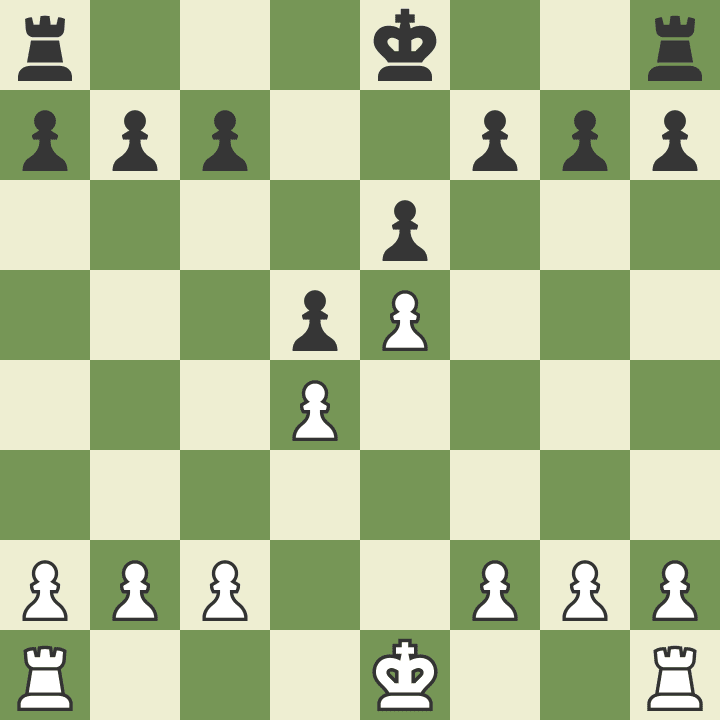
It is now white’s turn to move and therefore can choose what to play. Let’s say you want to castle short here:

The result would be a sort of fortified “castle” for the king that would fend off attacks. The group of pawns in front of the castle prevents most pieces from even making threats. I mean just imagine how would you even perform a check from this?
This is such a secure way of keeping the king safe. Since there are two types of castling, they also offer different advantages.
Short Castle (Advantages)
Choosing to castle short gives the following benefits:
● A more secure position than castling long, where the king is already highly safe after the said turn.
● Faster to perform in sense of only required to move two pieces from blocking the king and rook.
● Less likely to disorient pieces since there are fewer pieces to move.
● Much safer since it’s unlikely for someone to start pushing the kingside at the early phase of the game.
All of these are things to expect when castling short. These are all great benefits, however, it’s also important to note that chess is a positional game. Every chess principle ever will not apply to every single position.
The nature of the game is positional and maybe principle helps, but not dictate it. These advantages would be just common themes that are likely to happen between players. It doesn’t happen all the time especially in a rocky tournament.
But is still just a good reminder of the general idea of what to expect. This is the most common and first type of Castling. However, there is another type that we would want to learn if we are just starting to even become much more knowledgeable of this rule.
Long Castle
The long castle might just be the weirdest special rule you could ever find in chess. It involves a very long horizontal inter-switching that looks very unnatural. It basically is just the short castling, but the other way around.
Let’s bring up the diagram earlier:
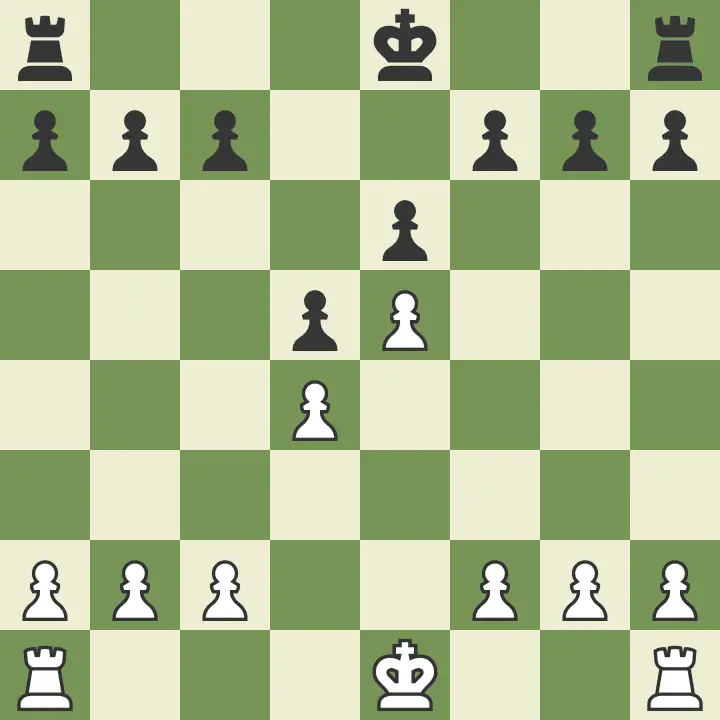
So this is the position from example before where we performed a short castle. But you can notice that the other rook on the left side is also not occupied. Can we not castle through that? Of course we can! That is the long castle.
Look:

The reason why I called this so unnatural is due to the seemingly long and stretchy move that this rule is performed. The king moves two squares which is something, but the rook moves a freaking tile of four!
Of course it can move on its own just like that. But the fact that we’re moving the King with it is just incredible. You can see that there’s a lot of possibilities to be exploited from this rule. Most players just blow over this option and try to castle short altogether.
But they are just losing a lot of potential off the table. Since there are certain situations where castling long is just the right thing. Let’s look at the advantages:
Long castle (advantages).
The following are the good things about long castling:
● It allows the free use of the kingside that allows the pawns to be pushed for an attack.
● Gets the side rook to influence the center while keeping the king safe with only just one turn.
● Would make it easier to block the kingside if the opponent seems to be over-pushing.
● Makes a lot of aggressive plays possible from making the castle move in itself very active.
These are all things this castling can offer and a lot of players just ignore it. Now I have written the best chess tips for beginners before, and one of my tips is to castle kingside (short). But that’s for beginners! Castling long after all is more complicated.
Knowing what you’re getting yourself into especially in castling is pretty important. It dictates the rest of the game. Basically short castling is a more passive approach, and long are for more ambitious pursuits.
Depending on what you’re trying to achieve, or the position to build are the factors that would be considered in choosing what’s best for you.
Those are the types of castling. However, with so many special rules in chess there are certain caveats that would have to be fulfilled first.
Conditions for castling
The following are the conditions for Castling. The special rules have to abide by certain rules themselves.
1.) The Rook must have not moved previously
A player cannot castle with the rook that has already moved from its starting tile. If you’ve watched the video earlier, it was discussed how the ruling in itself is created to only speed things up.
This is not in any way to bring any more complication to a somewhat already elaborate game.
If a player could caste after moving a rook, it may cause a new strategy that I would call “faking”. This is where a player signals an incoming attack by placing the rook into the side to possibly push a pawn, only to castle.
If a player chooses to move the rook early, this will ensure that the player will commit to that. Take this game for example:
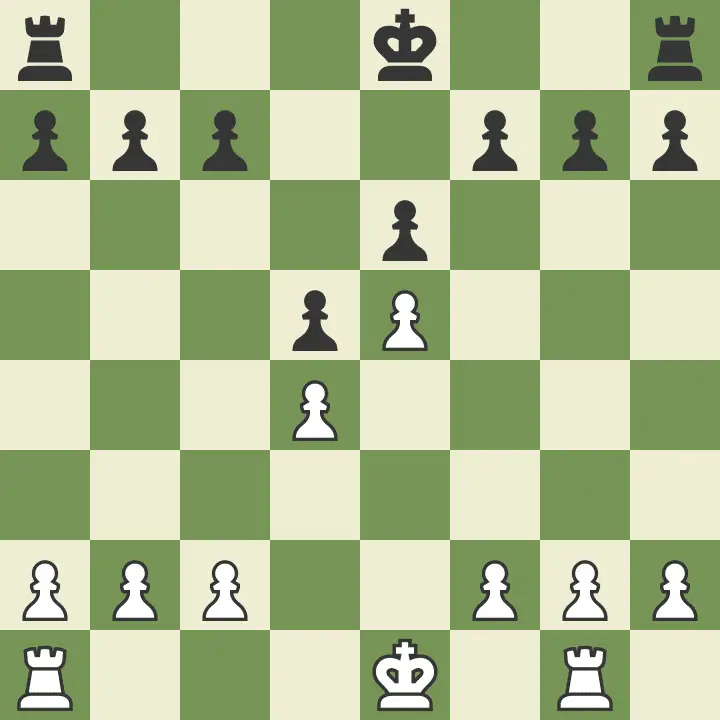
Now it’s white’s turn to move and can choose to castle. We can either castle Kingside (short) or Queenside (long) to our preference. Or can we? We can’t! The rook at the short castle has already moved from its starting tile.
Therefore we are unable to castle short since it does not meet one of the conditions for castling (the rook was not moved previously). However we should not forget that there are actually two rooks, not one.
Even when one rook has moved, the other one’s ability to castle (queenside) would not be removed.
Although we are unable to castle Kingside (short), doing so on the Queenside (long) is perfectly legitimate as the Queenside rook that will be involved with the actual castle has never moved before.
Taking this principle, it means that the side that has placed both of the rooks away from their starting tiles in any way will never be capable of castling for the rest of the game.
So if you are playing and plans to castle in the future, you need to ensure that both rooks (or at least one) remain on the starting tiles before doing so. Otherwise it will be considered an illegal move.
But have you noticed another thing in the pictures above? All of them don’t have any blockages in between.
2.) No pieces in between
Pieces in chess aren’t able to reside in the same tile at once.
You can only do so if something is captured or taken that in turn, such removes them off the board. There are other strategies to remove pieces from tiles like baiting and offerings your own pieces for example.
And that is the scenario this rule is trying to address in terms of castling. If you do castle in a path where two pieces can exist in a one-tile, then it kinda changes the game.
Look at this one:
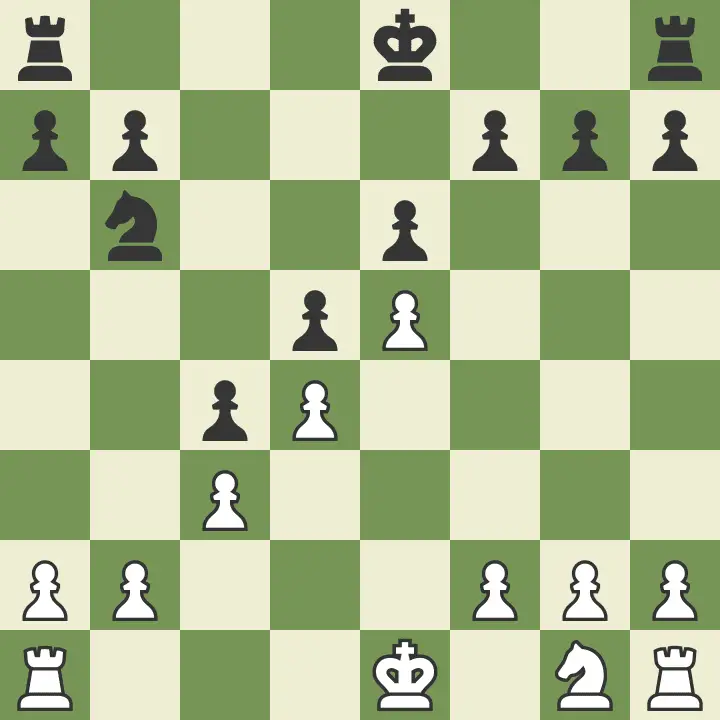
Let’s say you want to castle a short here. But the knight is on the way. How do we deal with this? If we castle here the Knight and King would be on the same tile. What happens then? Do you remove the Knight? Or do we remove the king?
All of these complications can arise. Therefore it’s been made where it can’t be done altogether if there are any pieces in between. Another interesting question would be what if you get checked? Can you castle out of it?
3.) Cannot castle when in check
Another of the conditions would be the current state of the king. You cannot castle when checked! It would be cool though if you can. Just see this diagram:
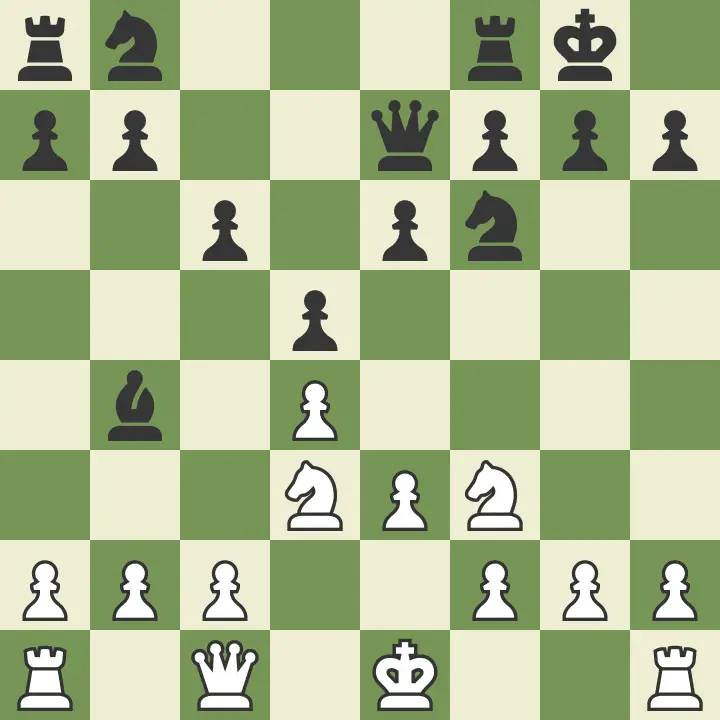
A check is a condition in chess where the king is at a threat of being captured. Black’s dark bishop in this case attacks the King diagonally. Therefore this is considered a “check”.
The King would have to respond. White in this case could either block with a pawn, capture the bishop, or move the King. What it can’t do is castle! I personally think that it can be done in a way that would not ruin the game experience.
But it is currently illegal! You can’t do that and you shouldn’t do that, cause you’ll get penalized. In an actual tournament not in street games of course.
4.) The King’s pathway to the castle is covered
Of all the conditions, this is the one that most beginners will only learn later.I think it’s better to just demonstrate with this:
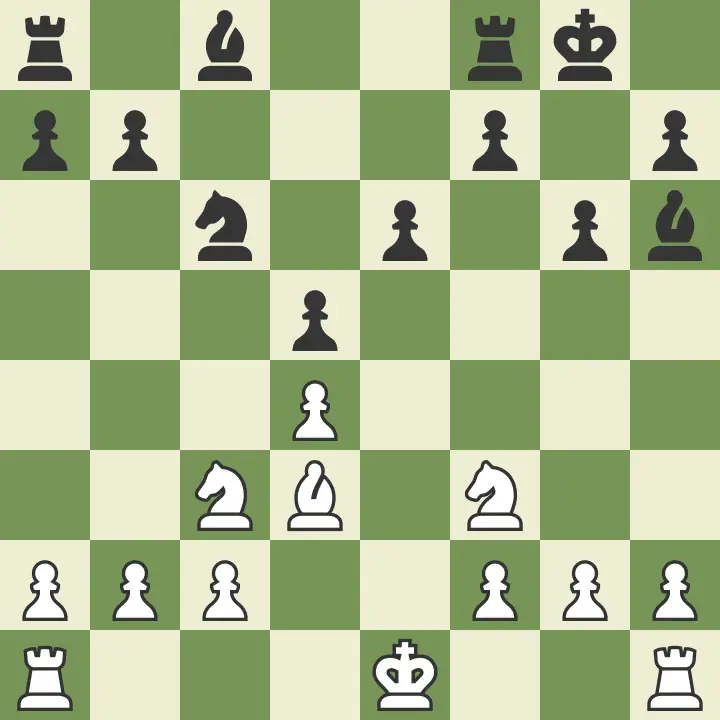
Let’s say White decides to castle long here. There’s a problem though. You’re moving the King into check! Look at Black’s dark-squared bishop slicing the King’s path to castle. Let’s say you’re stubborn and decided to do it anyway (which is illegal):
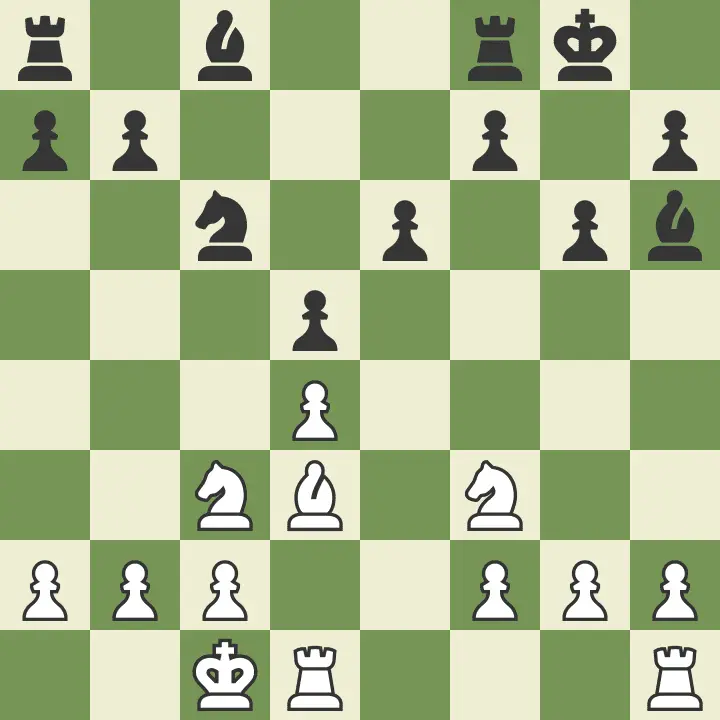
The king just moved into a check! Black can now capture the king. However, I don’t want you to think that this only applies to a King that will be placed under threat after the castle. Just look at this:
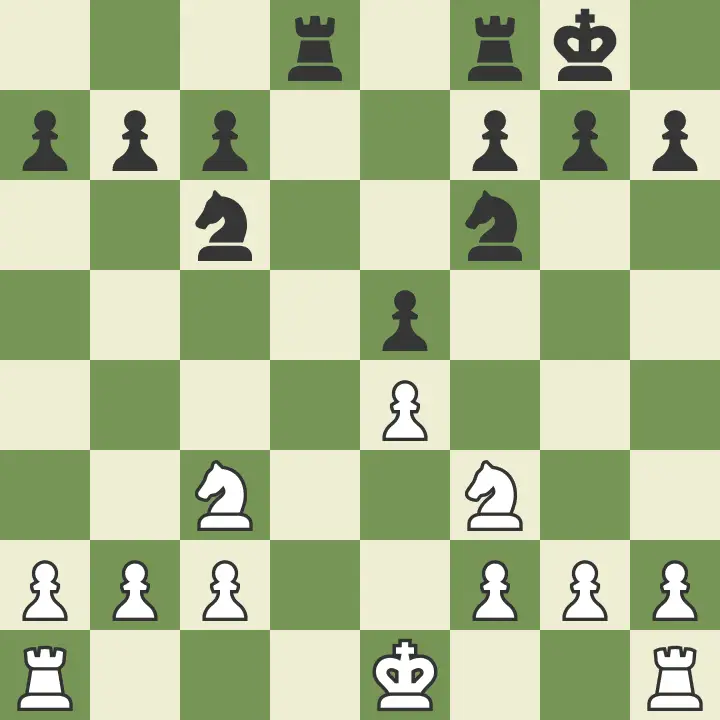
I want to castle long here. I can’t though, since it is considered illegal. The rook in this case covers the tile that would be used by the king before getting into the castled position.
So even though I technically am not checked after the long castle, I still can’t do it since the king’s path is covered.
To not get confused, if any of the first two tiles in the direction where the king is to move is covered, you can’t castle. There is one question that will arise with this though.
The Rook’s pathway to King is covered
What if it was the other way around? What if the tiles that will be used by the rook is actually the one getting covered? Is castling still possible? Just like in this example:
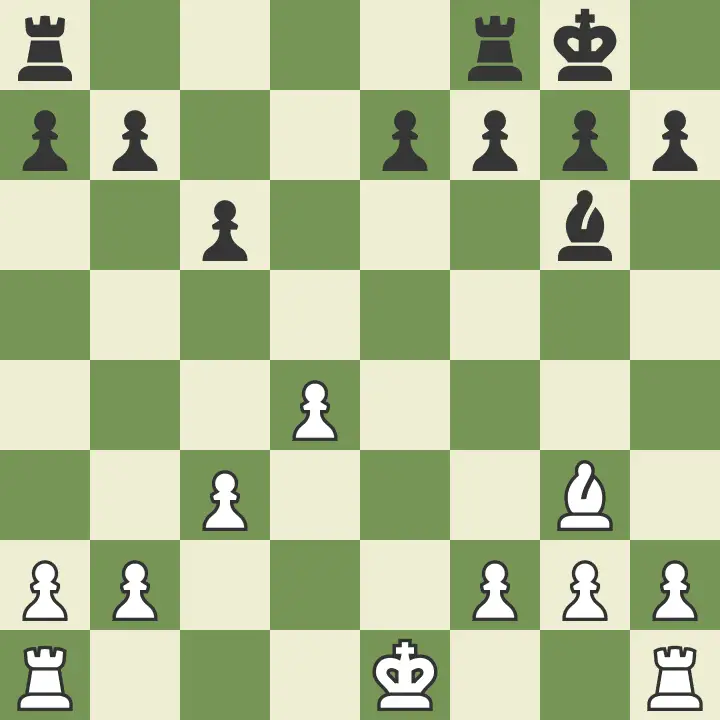
White desires to castle long here. However, black’s light bishop directly attacks the rook’s tile in the direction towards the castle with King.
The earlier rules state that we can’t castle if the king’s first two tiles get covered, but what if it was the same for the rook?
Can we still castle here? Yes! that is actually an option for white here. It doesn’t matter if the rook’s tiles get under threat.
That will only apply to the king, I don’t really know why but it is the case. Remember only the king can be prevented from castling not the rook.
Castling Principles
After all talk about all the factors needed to be fulfilled in order to castle, we need to know how to do it correctly.
Just like in chess, Castling in itself has its own set of principles, like mini principles. These are guidelines that you need to consider when making in-game decisions in a way that would maximize any inherent advantage. Here they are:
Castle early
If you’ve read or talked to somebody with experience on the game, well they might not even bring this up. Castling early is so frequently played that it basically becomes the norm. They also give the following advantages than not castling at all:
- Keeps the king safe in the corner in front of guarding pawns.
- Connects and activates both of the rooks for something useful.
- It can enable launching an attack on the opponent’s uncastled King while keeping your own safe.
This is due to the fact that the early stages of the game are mostly geared towards the center. Most pieces as well as pawns are clamped fighting for that little coveted space. This makes it easy to break the center and expose the king.
What you end up with is a naked king with a bunch of pieces hungry for a checkmate. And that’s probably a situation you don’t want to be in. Doesn’t necessarily mean that you can’t play that way.
A lot of professionals actually use this as a backup strategy (not castling).
But you’re most likely not a professional, and doing so would oftentimes lead to bad consequences. So we’ve talked about the two types of castling before. But what context do we choose to activate one over the other?
Choosing Short or Long Castle
Long and short castles offer very different gameplay for both players. You can expect a completely different game just from this one move. Different players have various references that are unique from each other.
We’ve already talked about the respective advantage and disadvantages earlier. Now it’s time to learn “when” to actually choose one over the other.
Take note that this is not absolute, there may be special positions for this where these do not apply. First Short castle.
Why would I Choose to castle Short?
Short castle also known as kingside castles are way more plausible to be selected in the following context:
1.) Passive Game
A player will always acquire a certain style of gameplay that is somewhat different from others. One of those is what we call “passive” style.
It usually involves making safe plays and hopefully getting little advantages that can incrementally be increased over time.
Not necessarily mean that risky plays are off the table. But only when it’s apparent and the returns are obvious.
This approach can be described as waiting for the opponent to make a mistake while limiting some of your own. It is plausible in a way that it doesn’t require you to go for some initiatives (risky plays). Of course, castling short can still be aggressive.
But most likely than not, a player would figure their desired setup before any attack can happen. There are few pieces after all that get in the way of a short castle than from a long one.
2.) Queenside Barrage
Castling on the side where most pawns have been pushed is always very risky. Just look at this example:
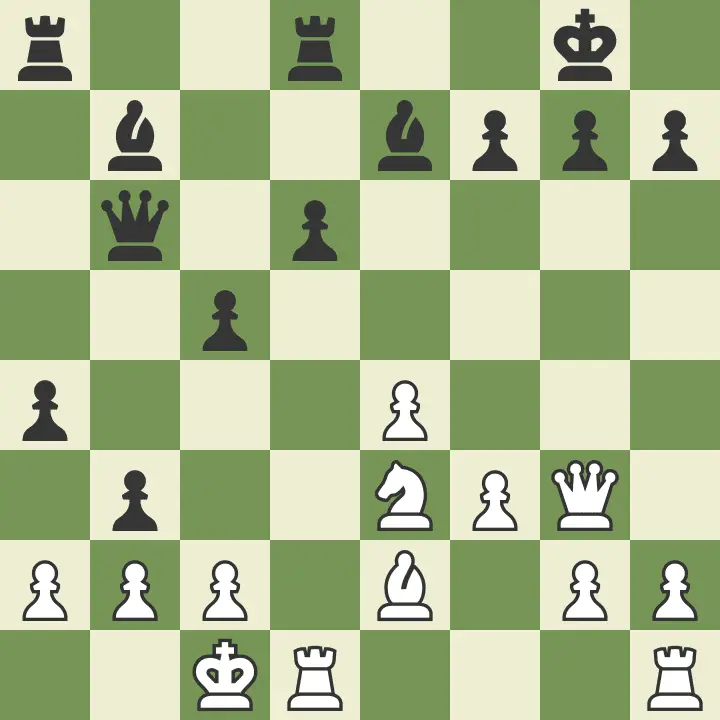
Since white castled on the queenside (long) here, the black pawns are ready for attack. It would be significantly harder to maintain a position like this.
That is why it is recommended to castle short since it’s way quicker and doesn’t give time for the opponent to push pawns.
3.) Castling fast
I’ve been talking about this a few times now. There is just so little amount of pieces between the king, and the kingside rook (Knight and light square Bishop).
Therefore a player can castle as quickly as possible and organized other pieces way quicker than with a long castle.
That is for the short castles. How about the long one?
Why should I choose to castle long?
A player should choose long castling in the following scenarios:
1.) Active Game
A player should choose to castle short when desiring a safe game. The opposite is true for long castles, it is a declaration to play an aggressive line. Just like this:
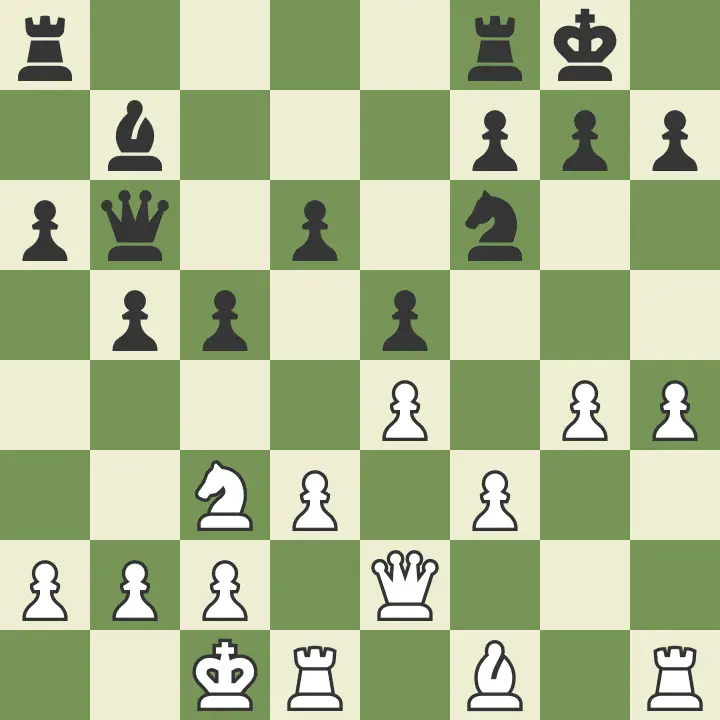
Both sides have castled under opposite sides of the board. White has long while black has short. Their respective pawns can now be pushed for an attack since the pawn pushes would not compromise their own king’s safety.
This is great for players who like short-term tactics than long-term strategies. If both sides castled long, this will not be the case though. However that is often not the case since it takes more pieces to develop when castling long.
2.) Ruined pawn structure
There will be cases where castling Kingside is just not that ideal. Pawn structures would also need to be considered. Case on point:
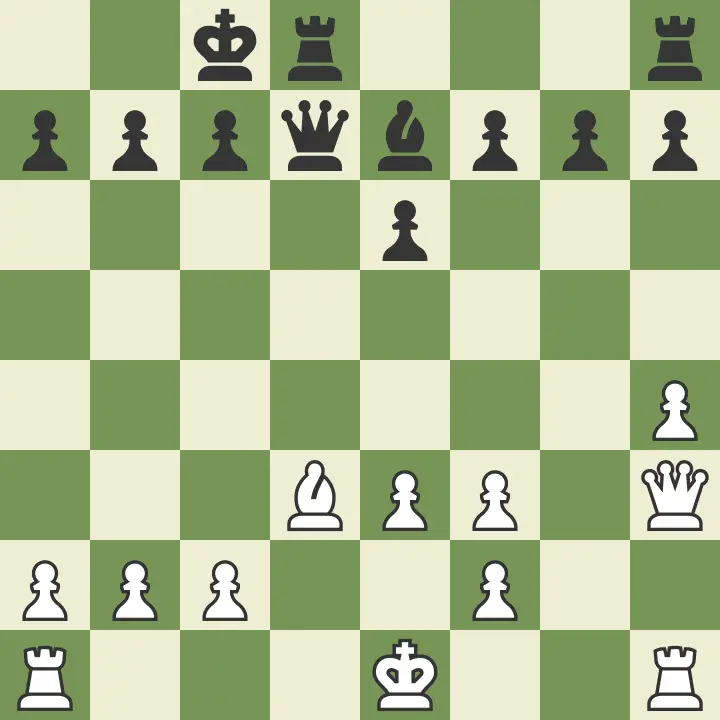
White’s Kingside pawn structure is in absolute shambles. Castling Kingside here would be terrible since it will leave the thing exposed to attacks.
3.) Ready for attack
The third case is where the kingside pawns are just placed in a way ready for attack. Just like this one:
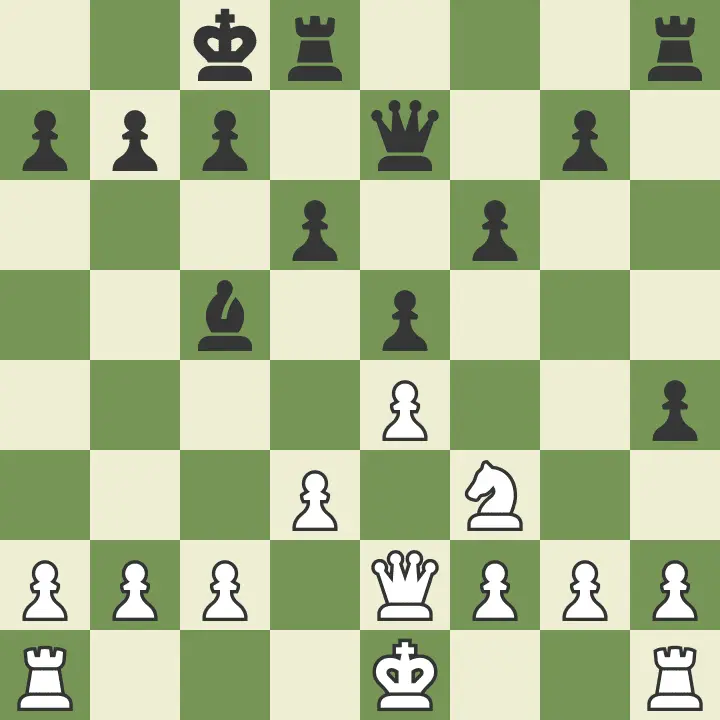
White is better to castle long than short here as the Kingside pawns are already in place to be pushed for the attack. It’s now black’s turn to move:
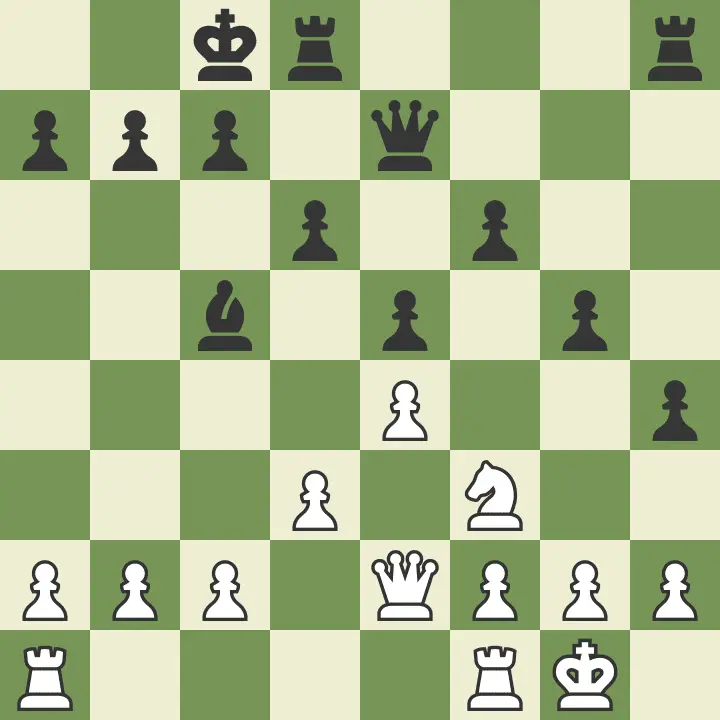
There’s now an attack! This wouldn’t have been possible if White castled short.
Not Castling at all
Now we’ve talked again and again about how castling is important. That still holds true. But again, chess is not cut and dry.
There will be positions and circumstances where not castling at all is the best idea. Here are the following caveats to look for whether abandoning castle is the right thing to go for:
1.) Endgame
One of the main features that a castled position has is a king tucked really far from the center. This is great early in the game since it keeps the king safe.
In endgames however (the phase where there are few pieces left) the king is one of the strongest pieces to be used by the player. Since it can cover a total of 8 squares without usually much threat of getting checkmated (captured).
This makes it able to escort both pieces on pawns much more easily. It cannot be done however if the queen is out of the game (in the corner). Castling where there are few pieces left would just keep the King from unleashing its full potential.
Traded Queens
One way to identify whether a chess game has reached the endgame would be the existence of Queens.
The Queens are primarily what constitutes a middle game where most attacks and tactics happen. Such “attacks and tactics” are often offered greatly by the queen.
It is after all the strongest piece in chess with all its diagonal, horizontal, and vertical reach. A queenless game is definitely a good sign that we’re about to enter the endgame if we’re not currently in it yet.
Of course it doesn’t necessarily mean that endgames cannot unfold with Queens. As endgames by definition are just the stage where there are few pieces left to even threaten the king.
A lot of firepower will be left off the board though when the queens are gone.
2.) Open Pawn Structure
Another factor to look for when deciding not castling at all is the conditions of both sides pawns. Take this one for example:
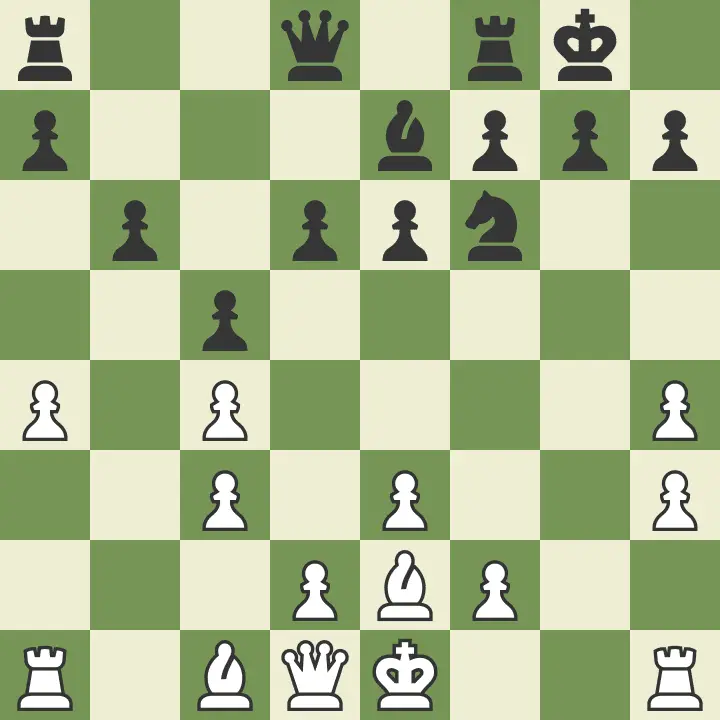
Both the Kingside and Queenside are busted from their respective pawns. What I mean by that is castling on both sides will get the king open for attacks. One of the main points of castling in the first place is to keep the king safe.
That simply cannot be accomplished if the pawn that supposed to guard the king is all ruined. This is why in this case keeping the king in the center might be the safest choice. And that brings us to the last condition.
3.) Closed center
The state of the center of course is a factor to consider whether to place the King in the center! One of the things we don’t want to happen to us is getting attacked by pawn pushes. Actually, getting attacked at all by anything.
But since the pawns are usually used for breakthroughs, that’s what we’re going to focus on. Just like in this one:
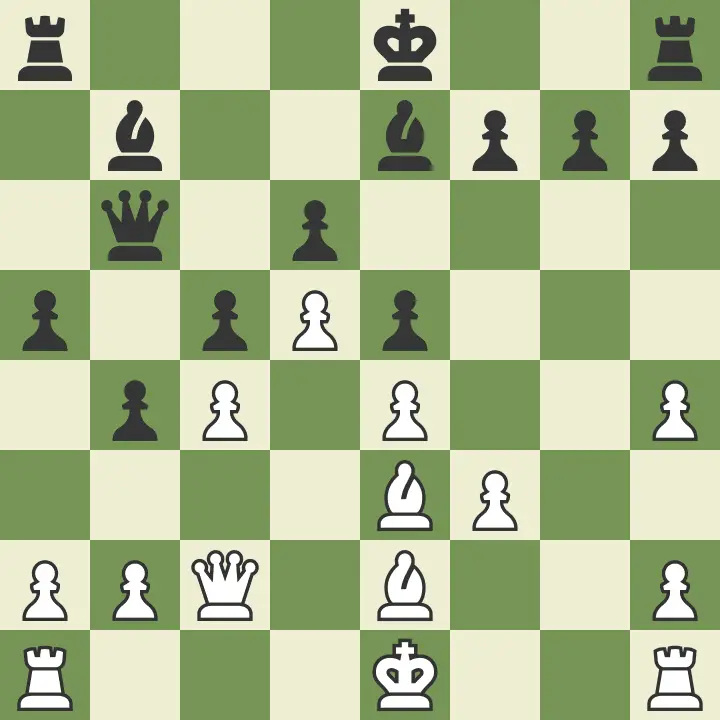
Look at those center pawns. The thing is pretty much shut tight. If you think about it those pawns actually guard the king. Look at both the king and queenside for example.
It’s terrible! The Kingside is open for attacks while the Black’s pawns are ready to march for the queenside.
Making the king stay in the center may actually be a good idea during such scenarios. Since we’re just discussing not castling at all, let’s talk about more of a general advantage and disadvantages of castling.
Advantages of Castling
Castling in general gives the following benefits:
1.) Keeps the King safe
I’m not really going to go deep on this one. I’ve talked about this over and over again throughout the article. But here’s why the king is usually safer when castled:
● The group of pawns in front of the king shields it from attacks.
● The center is where most open lines get created.
● There are fewer openings to be threatened within the corner than in the center.
● Most pawns and pieces are placed near the center, not in the corner.
All these factors ensure that a castled King is much safer usually, well usually. We’ve just talked earlier about the principle of not castling at all. But that is the exception not the case. More often than not, castling is actually the best course of action.
2.) Gets the Rook in the game
The rooks are placed in the furthermost corners of the board. Each of the four rooks is literally placed in all four corners at the start of the game.
Unlike the Knight, the Rook can’t jump over the pawns and would have to move those first. This blend of trickiness makes it harder to just even get the rook in the game.
Castling solves that problem. Just like in this diagram:

The rooks as you can see are perfectly connected to each other after white and black castled short. This is a feat that would have not been accomplished if white decided to keep the king in the center.
3.) Prevents royal pins and forks
Not castling puts the king in danger of being attacked by different pieces. Most notably, the Knights and Bishops. Forks are double attacks made by the Knight. A royal fork is a type of double attack by the Knight that involves either the king or the queen.
This is a royal fork:
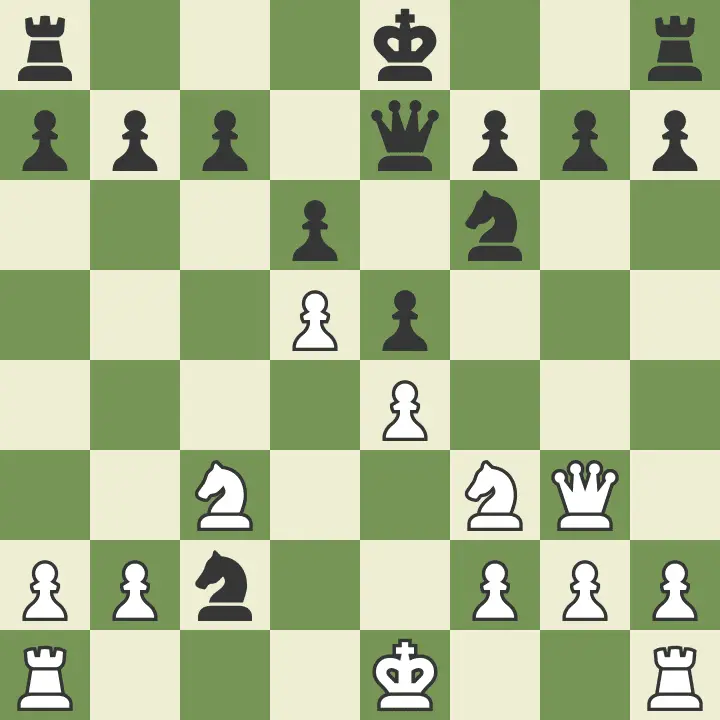
By staying at the center, the Knight was able to fork the king and rook together. The king would have to move and allow the Knight to capture the Rook. This would have been prevented if white only castled much earlier. What about the pins?
These are executed by the bishop, usually on Knights that get develop near the king. A royal pin involves a king or queen more than any other piece:
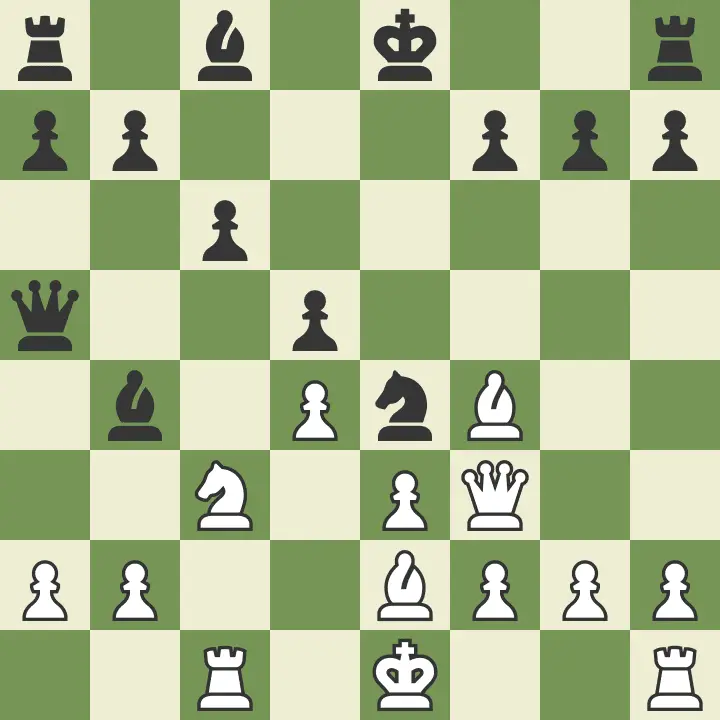
Pins incapacitate a piece from moving by indirectly threatening the one from behind if it ever moves. The Knight that was pinned by the bishop cannot move in this case as the King would be captured.
Again, this could have been prevented if the king castled much earlier. I have repeated again and again how useful it is to castle. But do you know that it has weaknesses too?
Disadvantages of Castling
The following are the drawbacks of choosing to castle at all:
1.) It cost tempo
Tempo is the amount of time a player consumes to get things done. Hence wasting tempo is a term only used to indicate a player making an unnecessary move from what’s needed at that moment.
Of course getting the King safe is always a good priority.
Well not always. There are situations where castling early actually gives time for the opponent to take the initiative. I know you’re thinking, but didn’t you say we should castle early? Yes I did say you should castle early, as a beginner.
There are times where you have to break principles to reach new heights. Sometimes postponing castling is actually a fair idea.
But then again, as a beginner, this shouldn’t make too much of a difference for most people. But is just something that we need to keep at the back of our mind, castling can lose time.
2.) The King gets out of the game
We have talked about how the King is actually an important part of the endgame. And this is indeed true. A King far away from the action at the endgame phase will always have a harder time than the one who is not.
Castling does just that! And although it keeps the king safe in the corner, it makes it harder for the thing to get activated later down the road. It becomes more likely for the opposing King to be more active than your own King that got stuck in the corner after castling.
This could be compensated though if the player gets to develop the King before that of the opponent’s.
3.) Might go into the line of attack
Now, this is not primarily caused by castling in itself. It is caused by castling in a bad time or on the wrong side of the board. If you read the discussion earlier, you know not to castle on the side where there is a broken pawn structure.
Now, that will surely decrease the probability of suffering from an attack. But it doesn’t necessarily mean that it will always be the case.
Your opponent could definitely start attacking anyway on your castled king even with no ruined pawns. So still be wary for attacks after the castle!
Conclusion
Castling definitely is an interesting rule in chess. It works wonders if executed properly and disastrous when implemented the wrong way. It is therefore imperative for a player to know how, when, and when not to castle in order to be a complete player.
If you’ve gone through and read everything here then you only need experience. So go out there, have fun and play chess.
